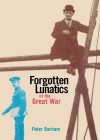Book Review - Forgotten Lunatics of the Great War
Forgotten Lunatics of the Great War
Written by: Peter Barham,
New Haven, Yale University Press, 2004,
ISBN: 9780300125115, 451 pp.
Reviewed by: John McCarthy
Peter Barham is a psychologist and a historian of mental health. Forgotten Lunatics of the Great War is a very successful attempt to rediscover the largely forgotten men who were certified as lunatics as a result of their 1914–18 war experiences. Wilfred Owen, killed in action on 4 November 1918 and awarded a posthumous Military Cross, noted such mental wounds in his poem ‘Chances’:
But poor young Jim, e’s livin and e’s not,
E’s wounded, killed and pris’ner, all the lot,
The ruddy lot all rolled in one, Jim’s mad.
Barham’s book analyses a segment of British social history. He discusses how the ordinary psychotic soldier was treated by the military medical officers, how they became absorbed inside the British asylum system and, importantly, how they were regarded by the English bureaucracy. The book thus is also an administrative history. As one civil servant in the Ministry of Pensions noted, the state should not be expected to support ‘...a man who becomes a lunatic because he is a coward and fears to undertake the liability which falls upon him as an Englishman’. Barham argues that it was popular pressure which contributed greatly to modifying such opinion.
The English class system often directed policy. As Barham points out: ‘The club of war psychotics is mainly populated by ordinary soldiers, but it also turns out there were rather more mad captains, barking brigadiers and other brass hats lurking in the psychiatric undergrowth than at first meets the eye’. Much has been written about the experience of officers suffering from shell shock. Owen himself, trapped for three days in a shell hole, was a mental patient. However, in Edwardian English society, officers were given preferential treatment. The term ‘shell shocked’, which removed the psychotic and lunatic stigma borne by the mentally afflicted common soldier, was largely reserved for the ‘officer class’.
Barham is surely right in resurrecting the injustices suffered by lower socioeconomic families as a result of the almost incomprehensible experience of the Great War. A question might be, however, what relevance might this book have for the present day Australian reader?
The book reminds us it is now axiomatic that ‘battle stress’, ‘battle fatigue’, ‘battle shock’ or whatever term might be used will always be part of a given battlespace. Examples are plentiful.
In the First World War it has been estimated some 25 per cent of discharges were labelled ‘psychiatric casualties’. In the Second World War the figure might have reached as high as 35 per cent. In Korea a soldier was twice as likely to become a psychiatric casualty as to be killed by enemy fire. Of those who returned home from the Vietnam War, at least 54 per cent claimed to have suffered or are suffering from Post-Traumatic Stress Disorder. In the 1990–91 Gulf War, 34 per cent of American troops reported themselves as having been subjected to significant psychological stress. Even the much vaunted, and in some eyes, almost hallowed, Israeli army is far from immune. In the Yom Kippur war, 30 per cent of all Israeli casualties were psychiatric cases. Large casualties were suffered in the 1984 Israeli invasion of Lebanon. Psychiatric casualties exceeded those killed by 150 per cent.
There is no reason to believe the Australian soldier of the twenty-first century will prove immune from the stress of battle, even if such conflict is limited to so-called ‘fourth generation’ engagements without set-piece battles. The Australian Army has five active battalions. It is currently 2000 personnel under strength. If the suggested proposal to increase the size of the Army by two battalions is adopted, it will have to recruit and retain some 4000 soldiers over the projected decade of expansion. Given the current retention rate, this target might not be met. What the Army cannot afford, therefore, is to suffer a high percentage of avoidable psychiatric casualties. Peter Barham offers some insights into the way such casualties were treated in the past and what policies might be avoided today. While one might well be confident that current planning is fully aware of the psychological problems of modern warfare, a glimpse into the past might still be rewarding.
The book reminds us it is now axiomatic that ‘battle stress’, ‘battle fatigue, ‘battle shock’ ... will always be part of a given battlespace.



